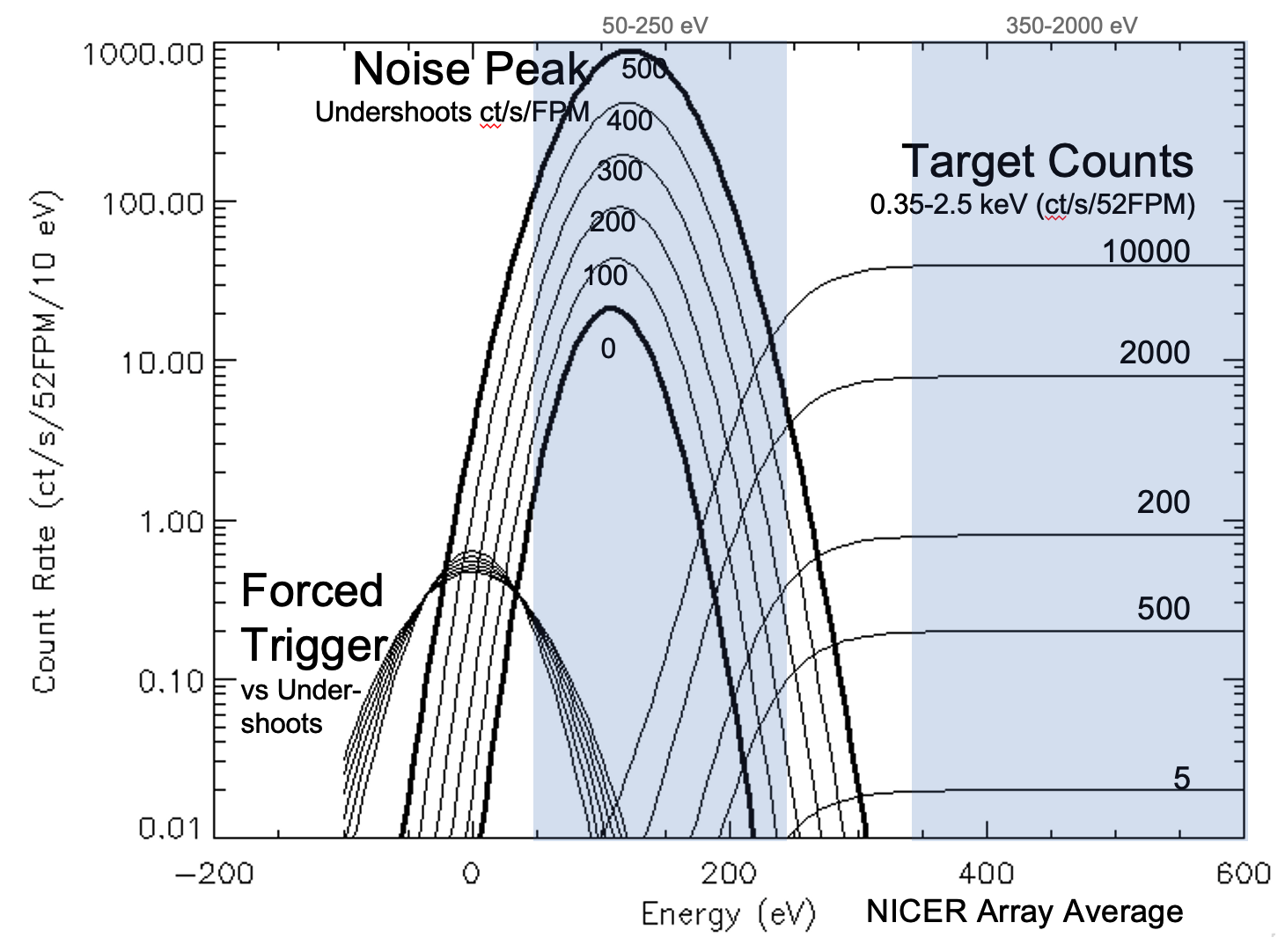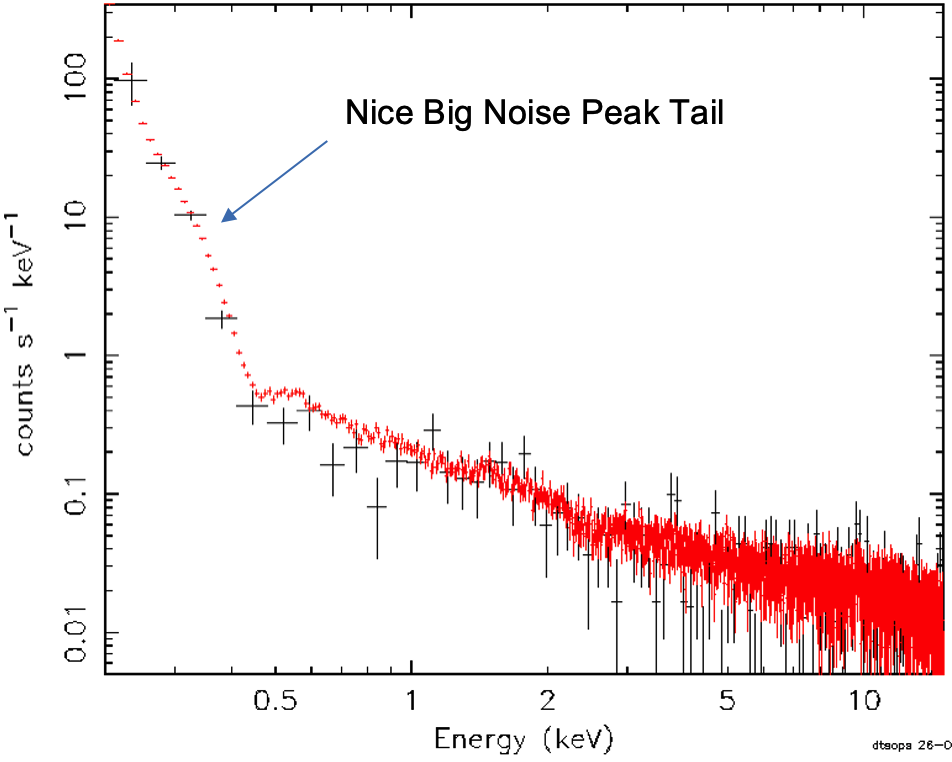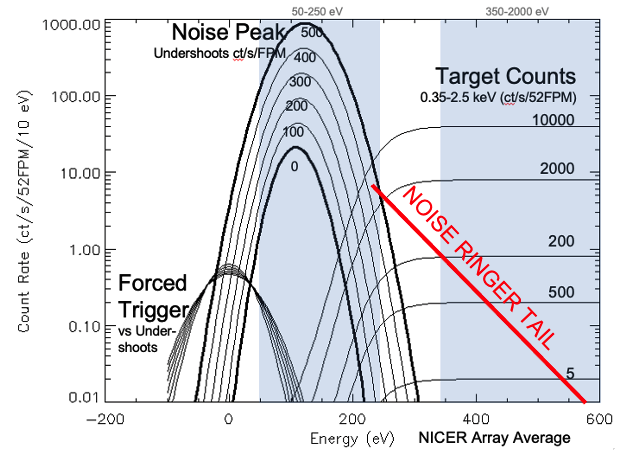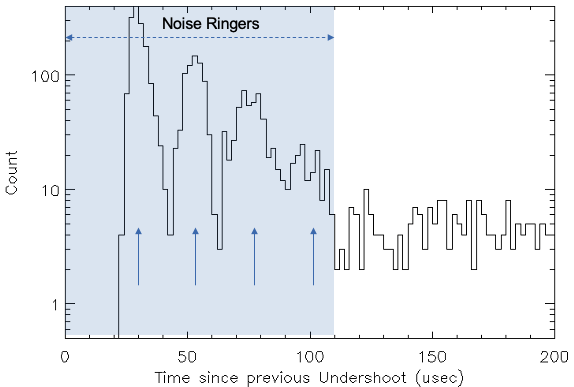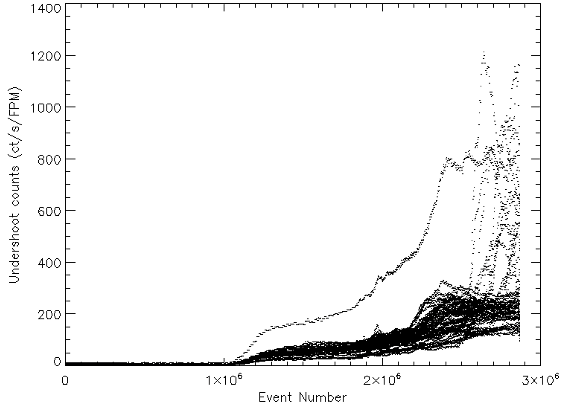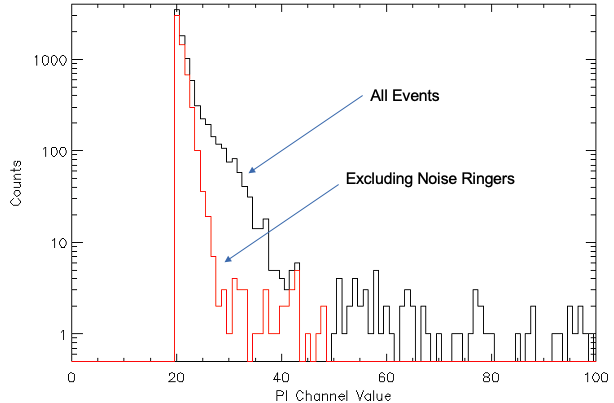NICER "Noise Ringer" DiscussionReturn to: Analysis Threads | Analysis Main Page
OverviewThe NICER team is now aware of a new detector artifact that affects the quality of spectra. This effect appears at high undershoot rates (high optical light loading), and appears primarily as an extended noise tail in the 0.2-0.6 keV energy range. We discuss the nature of the effect and how to mitigate it in this thread. Read this thread if you want to: Understand and mitigate the effects of "noise ringers." Last update: 2023-08-01 IntroductionNICER is an X-ray observatory mounted on the International Space Station or ISS. It is designed to observe astronomical X-ray targets with sensitive silicon X-ray detectors. The silicon detectors that NICER uses, which are sensitive to X-rays, are also sensitive to optical light. The NICER team understands many of the effects of optical light on NICER's detectors. These include:
The NICER team has found a new detector artifact that can affect spectra. This artifact primarily appears as an "extended tail" of the noise peak, in the 0.2-0.6 keV energy range. It also appears only in high optical light loading conditions (high undershoots). The NICER team calls this effect, "noise ringers." After the optical light leak issue that begain on May 22, 2023, the chances of having noise ringer contamination has increased significantly. This is because optical light loading conditions are now much higher compared to before the leak developed, and the effect is triggered by these conditions. However, the effect can be present in any spectrum, pre- or post-light leak, where optical light loading is high. For a more detailed discussion of optical light loading, and the undershoot count rates that are used to diagnose light loading, please see the Introduction to Undershoots and Optical Loading page. This analysis thread walks through the symptoms of "noise ringers," the conditions under which they develop, and how to mitigate the problem. What Are Noise Ringer Artifacts?Here we discuss the noise ringer phenomenon and its symptoms. The effect is visible as an extended noise tail, most prominent at low energies, and declining to background at around 0.5-0.6 keV.
Before we go into a more detailed discussion, we should recognize
the normal behavior of NICER detectors and the features that occur
at low energies.
The figure shows that at low energies, there are several features to notice. The forced trigger peak is centered, by construction, near 0 keV. This peak has a constant count rate, but its broadness (resolution) depends on undershoot level as shown. A sample target spectrum is also shown, assuming a "flat" spectrum but various overall count rate levels. The source spectrum as affected by the low energy trigger efficiency function (or threshold) which gradually transitions from full detection efficiency above ~0.4 keV to zero detection efficiency below ~0.2 keV. The most remarkable feature is the noise peak, which is typically centered at about 0.12 keV and a 1-sigma width of 35 eV. The noise peak grows more intense and broader with increasing undershoot levels. However, it is clear that even at the highest intensity undershoot level, the nominal noise peak never does not extend above ~0.3 keV. Noise ringers extend beyond this, in the 0.3-0.6 keV range as an extended tail.
Below is an example spectrum exhibiting noise ringer artifacts.
During this spectrum, the undershoot level is ~450 ct/s/FPM.
As noted above, the nominal noise peak only extends to 0.3 keV maximum, and the noise ringer peak is a feature that extends up to 0.5-0.6 keV. Now we can summarize the symptoms of noise ringers.
Graphically, noise ringers can be shown on a similar detector feature
schematic, as shown below.
The science impacts are
We reiterate here that noise ringers can occur any time optical loading is high, not just after the light leak developed. However, noise ringer events are more probable after the light leak developed. Underlying Root CausesThe NICER team has a basic understanding of where noise ringer events come from. Individual noise ringer events occur within ~100 microseconds after an undershoot in the same detector. Thus, noise ringer events are correlated with the nearest undershoot. In addition, noise ringers are correlated with the rate of undershoots.
Below, we show a histogram of the waiting time between an event in a
detector and the most recent undershoot. The example is from the
same observing time of the spectrum in Figure 2 shown above.
The histogram in the figure shows that there is an enhancement of counts between about 0 and 110 usec after an undershoot. Normally we expect the detector to be "dead" for a few tens of microseconds after an undershoot, which is shown here, but then the count rate increases by a factor of almost a 100x in some portions of the histogram. (However, since the time window where this occurs is very brief, it does not mean that the overall count rate increase due to noise ringers is so high.) Additional substructure is visible as peaks in the histogram, at multples of ~26 usec. Since astrophysical X-ray photons cannot be correlated with detector undershoots, this must be a detector artifact. It is believed, but not well understood, that electronic "ringing" can occur in the NICER front end electronics after an undershoot reset and at high leakage currents, hence the name "noise ringers." An undershoot reset is a very large negative pulse which injects a correspondingly very large transient into the front end electronics, and it is conceivable to believe that some component of the electronics is susceptible to ringing. The presence of periodic substructure to the artifact supports that conclusion. The NICER team believes that the detector remains sensitive to X-rays during this 110 usec time period, and thus is not "dead." However noise ringers provide an additional detector "background" that makes analysis of faint sources in the soft energy band difficult, if undershoot rates are high enough. Undershoot DependenceAs noted above, noise ringer artifacts appear only above a certain undershoot rate. Here we demonstrate that property.
The following figure shows an observation of the Crab nebula taken
under varying undershoot levels.
In the figure's top panel, the onset of noise ringers is apparent around time 1.9x106 seconds. The characteristic multi-peak ringing effect begins to show up around that time and becomes more pronounced as time increases. Below that time, the events are free of noise ringers. In the bottom panel we see that the onset occurs when undershoots are above about 80 ct/s/FPM, and then the undershoots increase at later times. Thus, noise ringer events become apparent when undershoot count rates exceed ~80 ct/s/FPM, and become more pronounced as undershoot count rates increase higher. In addition, please note that individual detectors can have different undershoot count rates. This can be due to varying lighting conditions within the NICER instrument mechanical structure, as well as different susceptibilities of individual detectors in their response to optical light photons. Ultimately we need to track undershoots on a detector-by-detector basis to diagnose this issue, although the per-FPM average rate is useful as well, though slightly cruder. Mitigating the Effects of Noise RingersThe NICER team has two recommendations for mitigating the effects of noise ringers. These recommendations depend on whether the scientist has "newer" or "older" software, but other factors like the background model being used may be important. Overall, the NICER team recommends reprocessing data that may be affected by noise ringers with HEASoft 6.32 or newer. If undershoot count rates (FPM_UNDERONLY_COUNT) exceed ~80 ct/s/FPM, reprocessing with new software is recommended. Reprocessing with HEASoft 6.32 or Higher (Recommended)Beginning with HEASoft 6.32 (NICERDAS 11) and higher, the standard NICER processing pipeline nicerl2 can automatically screen and remove noise ringer events. This is the recommended approach for most scientists. The task nicerl2 performs this automated screening. The operation of the screening is governed by two parameters to the nicerl2 task.
At the most extreme undershoot levels (~500 ct/s/FPM), this screening introduces an effective deadtime of <5%. Internal tasks called by nicerl2 determine the "time since undershoot" property of each event. The recommended 110 usec timing window is essentially hard-coded. Events which meet the criterium are not immediately screened out, but rather assigned the 0x40 bit in the EVENT_FLAGS column of the event file. All events, noise ringer or not, are kept in the "ufa" event file. Only in the later "nicerclean" steps are the specific noise ringer events removed based on both the bit flag as well as the undershoot count rate threshold.
Users can determine if the newer software has been run on their event
data by looking for the UNDRTIME keyword, which is appended
to the "ufa" and "cl" event files by the internal screening tasks. A
command like this,
After running a modern version of nicerl2, noise ringers will be removed from the screened "CL" event file.
Here is an example of the same spectrum as above, both before and
after noise ringer automatic screening.
The figure shows the spectrum both before screening (black) and after the automatic screening (red). It's clear that in the energy range 0.3-0.5 keV (PI channels 30-50), a significant number of noisey events has been removed. Please note that noise ringer screening does not remove the noise peak itself. The noise peak cannot be screened out by any standard techniques. The red curve shows the noise peak still dominates below 0.25 keV, and has some counts up to about 0.30 keV, but this is to be expected based on Figure 1 above. The noise peak itself, in terms of centroid, width, and amplitude, is modeled by the SCORPEON model by default. 3C50 background model. The 3C50 model does have a noise peak model, which includes noise ringer tail in the spectrum, since those events were part of the training data set. However, the 3C50 model provides an average of many conditions for its estimatated noise peak contribution. In some cases, this average will be representative, and in other cases it will not. If you are using the 3C50 background model, screening out noise ringers may or may not help. The 3C50 model does not have a way to recognize when you do or do not apply the screening, so it will continue to subtract its average estimated noise tail. This is likely to be an oversubtraction. If soft spectrum science is important, consider trying the SCORPEON model to regain low energy performance, or use the undershoot cut in the next section instead. The NICER team is working with the 3C50 author to revised the model to account for screening of noise ringers. Space Weather background model. The Space Weather model does not treat the noise peak in any special way. The Space Weather model was trained on all background data, regardless of the noise peak and optical loading conditions. Therefore, it is unlikely to produce an accurate estimate of the noise ringer tail. Users are advice to consider moving to the SCORPEON model if low energy spectroscopy is important. In summary, the nicerl2 task available in HEASoft 6.32 and higher provides automatic screening of noise ringers. For soft science, the results are best handled by the SCORPEON background model. Legacy Screening: Undershoot ThresholdIf you are processing data with software older than HEASoft 6.32 (NICERDAS 10 or earlier), automatic noise ringer screening is not available. Your next best approach is to restrict the undershoot range for your data. If you are using the 3C50 or Space Weather models, and care about soft spectroscopy, using a restricted undershoot range as described here may also be viable. As noted above, the undershoot range of 0-80 ct/s/FPM is free of noise ringer events. Since the onset of noise ringers is gentle, a slightly looser range of 0-100 ct/s/FPM may also be acceptable. Please note that the default range for undershoots is 0-500 ct/s/FPM.
This can be accomplished by altering the underonly_range parameter
when running nicerl2. Here's an example:
As a side note, if you are experimenting with various screening parameters and re-running nicerl2 multiple times, you do not have to wait for nicerl2 to completely re-process everything from the raw data. You can use the "tasks" and "incremental" parameters of nicerl2 to avoid lengthy reprocessing. Please see the Making nicerl2 Run Faster section of the nicerl2 page. Please note that performing this more restrictive screening increases the chances of reduced exposoure, or even zero exposure. If you are reading this page, you are likely dealing with an observation with very high optical loading conditions, and the undershoot rates may be high throughout the data set. Making a restricted undershoot range may exclude most or all of your data. If that is the case, your best course of action may be to upgrade the software to a more recent version to get automatic noise ringer screening. Using a restricted undershoot range may be a good approach if you are using HEASoft 6.31.1 or earlier, or are using the 3C50 or Space Weather models. However, there is a risk that a signiicant fraction, or maybe all, of the data is removed by this restricted undershoot range. Next StepsAfter performing either of these screening steps, you are ready to make products. Modifications
|


